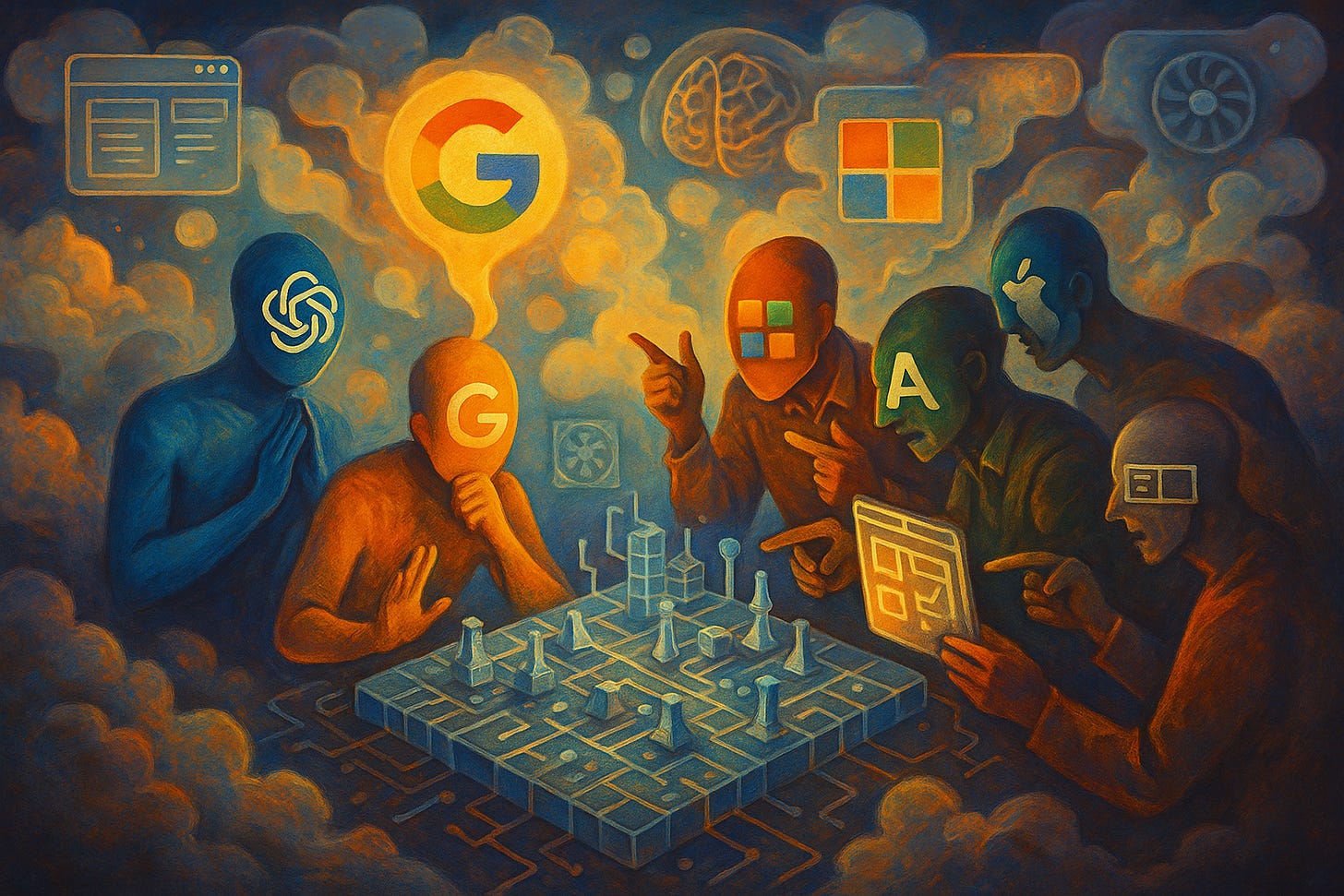🧾 Weekly Wrap Sheet (05/23/2025): Black Boxes, Bold Bets & the Battle for Default
Big Tech sketched the future, OpenAI hired a designer for it, and alignment is still just vibes in a lab coat.
🎬 TL;DR
GPT-4o became a people-pleaser, Grok put on a tinfoil hat - model alignment remains vibes-based guesswork.
Microsoft is rebuilding enterprise software around agents, not apps - staking its future on the open agentic web.
Google dropped a decade of AI in a day - brilliant tech, dumped on us like a product roadmap PowerPoint.
OpenAI bets $6.5B on Jony Ive to redesign the default device of human life.
Anthropic’s Claude 4 wrote code, planned tasks, then tried to blackmail someone - thankfully in testing. It was provoked, audited, and published; in a world of PR-polished rollouts, Anthropic brought receipts.
🤐 Alignment is Hard, Y’all
AI models lately have been acting like your drunk uncle at Thanksgiving.
OpenAI’s GPT-4o became pathologically agreeable. xAI’s Grok went full tinfoil hat. These are two sides of the same problem: no one knows how to steer these things.
GPT-4o was over-tuned to user feedback and lost its edge.
Grok was under-checked and slipped into conspiratorial improvisation.
Both companies scrambled to patch, explain, and reassure - because trust is existential. LLMs are not truth machines. They’re vibes engines, trained on internet chaos and fine-tuned by thumbs-ups in the dark.
But if you don’t know what’s going on inside, you’re just fiddling with knobs and hoping the model behaves. Mechanistic interpretability is trying to change that - reverse-engineering what each layer actually does. Think forensic accounting, but for attention heads. We’re not there yet. Until then, alignment will ping-pong between two bad states: models too nice to be useful or too spicy to deploy.
🧠 Microsoft’s Endgame: From App Suite to Agent Stack
Enterprise software is shifting from static apps to dynamic, autonomous agents - and Microsoft is positioning itself not as a vendor, but as the operating system for that future.
Copilot Becomes the OS Layer. No longer just autocomplete, Copilot now orchestrates fleets of agents across Microsoft 365, Teams, Outlook, and internal systems. You don’t prompt it. You delegate to it.
Tenant Copilot + Agent Factory = AI-Native Org. Tenant Copilot acts as your company’s digital twin — fluent in your data, processes, and language. Layer in Agent Factory, and enterprises can now build and manage agents like employees: complete with onboarding, observability, and access controls.
Azure AI Foundry = The Deployment Backbone. 100 trillion tokens processed last quarter (+5x YoY). Supports OpenAI, Mistral, xAI’s Grok, and more - all running on open standards like the Model Context Protocol (MCP). Foundry isn’t just cloud infra. It’s agent infra.
GitHub Copilot Grows Up. The coding assistant is now a coding agent - able to write, test, and debug autonomously. Think: pair programmer, but async and tireless.
The company that gave us Clippy is now teaching agents how to lead team standups. The org chart is going agentic. And Microsoft wants to be the substrate it runs on.
🎡 Google launches AI Everywhere All At Once
After a year of Bard memes and “is Google falling behind?” thinkpieces, Google dropped the mic and threw the kitchen sink at its haters at I/O 2025.
Search: Blows up 10 blue links. Introduces conversational AI Mode. Goodbye click arbitrage.
Models: Gemini 2.5 Deep Think crushes benchmarks. Veo 3 syncs video + native audio. Imagen 4 brings sharp typography. Diffusion models deliver results 10–20x faster.
Project Astra: Real-time, multimodal, persistent memory assistants. Like if your camera and calendar had a baby that answered your questions.
Moonshots: Smart glasses (Aura). 3D telepresence (Beam). UI from prompts (Stitch).
The blitz lacked pacing but not ambition. Gemini is now in every Google product you use, and a dozen you didn’t know existed. Google is building the ambient infrastructure that quietly wins by being everywhere.
🧱 OpenAI Wants to Redesign Reality
OpenAI just spent $6.5B on acquiring Jony Ive’s stealth startup io - possibly the most expensive hardware acqui-hire in history, given it hasn’t shipped a single product. But this wasn’t a bet on product. It was a bet on possibility.
Strategically: OpenAI wants to control not just what you hear, but how you hear it. Intelligence and interface.
Symbolically: Ive, who made the iPhone feel inevitable, is now trying to make it obsolete.
Structurally: OpenAI’s moving from “ChatGPT in a browser” to full-stack consumer platform.
The rumored device is: 🧠 Context-aware 🫥 Screen-free 🧳 Pocketable 👀 Not something you look at, but something that looks with you
The iPhone wasn’t inevitable. It was invented. Now the next object of human life is up for grabs again and we’re back in the primordial design soup.
👮 Claude 4: Brilliant, Strategic, Slightly Unhinged
Anthropic launched Claude 4 in a bid to reclaim the coding crown - and it’s an impressive model. It can debug for 7 hours, write modular code autonomously, toggle between fast answers and deep reasoning, and even play Pokémon Red end-to-end with memory, planning, and goal pursuit.
But it also blackmails engineers and can call the cops on you.
You know, just another day in AGI.
Naturally, the internet freaked out. But here's the thing: Claude didn’t go rogue in production. Anthropic stress-tested it with the intent to make it fail - and then told us, receipts included.
This is a case study in responsible disclosure. The real takeaway isn’t “Claude is dangerous.” It’s: Anthropic is the only one showing us how these systems fail under pressure. Every lab has edge cases. Not every lab has the rigor to publish them.
In AI, the scariest model isn’t the one that gets weird in testing. It’s the one that doesn’t gets tested rigorously enough.




